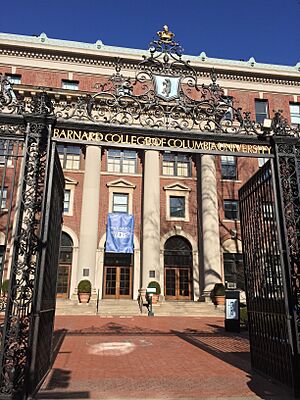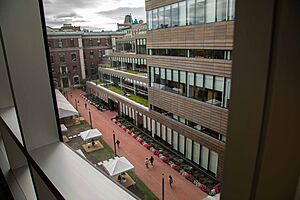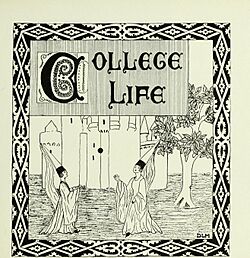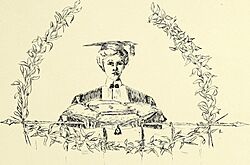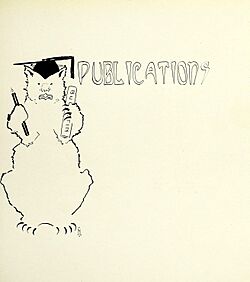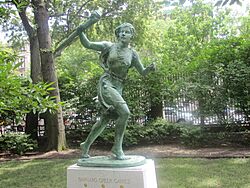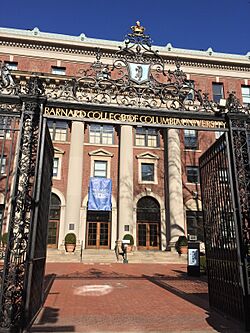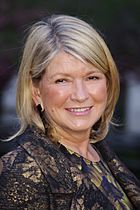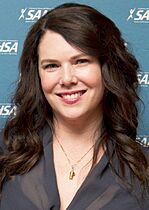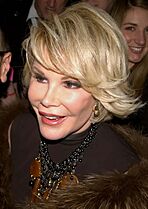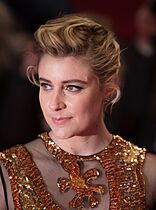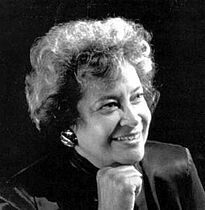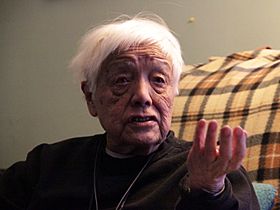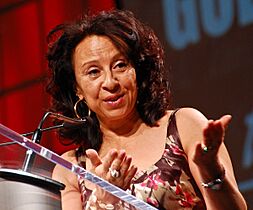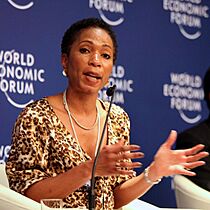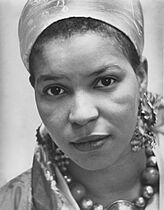Barnard College facts for kids
 |
|
| Latin: Barnardi Collegium | |
|
Other name
|
Barnard College of Columbia University |
|---|---|
| Motto | Ἑπομένη τῷ λογισμῷ Hepomene toi logismoi |
|
Motto in English
|
Following the Way of Reason |
| Type | Private women's liberal arts college |
| Established | 1889 |
|
Parent institution
|
Columbia University |
|
Academic affiliations
|
|
| Endowment | $447 million (2022) |
| President | Laura Rosenbury |
|
Academic staff
|
388 (fall 2022) |
| Undergraduates | 3,442 (fall 2022) |
| Location |
New York City
,
New York
,
United States
40°48′35″N 73°57′49″W / 40.8096°N 73.9635°W |
| Campus | Urban |
| Colors | Blue and white |
|
Sporting affiliations
|
NCAA Division I – Ivy League (consortium with Columbia University) |
| Mascot | Millie the Bear |
 |
|
Barnard College is a private college for women in New York City. It is connected with Columbia University. It was started in 1889 by a group of women, led by a young student named Annie Nathan Meyer. They asked Columbia University to create a college just for women. They wanted to name it after Columbia's president, Frederick A. P. Barnard.
Barnard College is one of the original Seven Sisters. These were seven colleges in the Northeastern United States that were historically for women. Even though Barnard is linked to Columbia, it has its own admissions, classes, and money. It shares sports teams with Columbia through a special agreement. This makes Barnard the only women's college to compete in NCAA Division I sports.
Students at Barnard can earn a bachelor of arts degree in about 50 different subjects. The college campus is about 4 acres big. It is located in the Upper Manhattan area called Morningside Heights. It is right across from Columbia's main campus. Many Barnard graduates have become leaders in science, politics, medicine, and the arts. They have won many awards, like the Pulitzer Prize.
History
How Barnard College Started
For a long time, Columbia College only accepted men for their undergraduate programs. Barnard College was founded in 1889 because Columbia would not admit women. The first classes were held in a rented building. There were 36 students and six teachers.
The college was named after Frederick Augustus Porter Barnard. He was a deaf educator and mathematician. He was also Columbia's president for over 20 years. He believed that men and women should study together. In 1879, he suggested that Columbia admit women. Columbia's leaders said no many times. But in 1883, they agreed to let women study and earn degrees.
Annie Nathan Meyer, a former student, and other important women in New York convinced Columbia to create a women's college. This college would be connected to Columbia. Both men and women were part of the first group of people who helped start Barnard College.
Moving to Morningside Heights
In 1892, Columbia University announced it would move to a new area called Morningside Heights. Barnard College also built a new campus nearby. This was possible because of gifts from people like Mary E. Brinckerhoff, Elizabeth Milbank Anderson, and Martha Fiske.
The first classes at the new campus were held in 1897. Important buildings like Milbank, Brinckerhoff, and Fiske Halls were built around this time. Later, Brooks Hall and Hewitt Hall were also built. Students' Hall, now called Barnard Hall, was built in 1916.
By the middle of the 1900s, Barnard was very successful. It was giving women a top-notch education. In the 1970s, there was pressure for Barnard to join with Columbia College. But Barnard's president, Jacquelyn Mattfeld, strongly resisted this idea.
College Presidents
Here is a list of the leaders of Barnard College from when it started until now:
- Ella Weed (1889–1894)
- Emily James Smith Putnam (1894–1900)
- Laura Drake Gill (1901–1907)
- Virginia Gildersleeve (1911–1947)
- Millicent McIntosh (1947–1962)
- Rosemary Park (1962–1967)
- Martha Peterson (1967–1975)
- Jacquelyn Mattfeld (1976–1980)
- Ellen V. Futter (1980–1993)
- Judith R. Shapiro (1994–2008)
- Debora L. Spar (2008–2017)
- Sian Beilock (2017–2023)
- Laura Rosenbury (2023–present)
Academics
Barnard students can earn a bachelor of arts degree in about 50 different subjects. They can also take part in special programs with Columbia University, the Juilliard School, and the Jewish Theological Seminary.
The most popular subjects for graduates in 2021 were:
- Economics
- Psychology
- History
- English
- Political Science
- Neuroscience
- Art History
Barnard has general education requirements called "Foundations." Students must take science classes (one with a lab), study a foreign language, and take classes in arts, humanities, and social sciences. They also need to complete courses in "Modes of Thinking."
Admissions
Barnard College is known for being very selective when admitting students. It is the most selective women's college in the United States. In 2017, it had the lowest acceptance rate among the five Seven Sisters colleges that still admit only women.
For the class of 2026, only 8% of the 12,009 applicants were accepted. This was the lowest acceptance rate in the college's history. The average SAT score for admitted students was 1440. The average ACT score was 33.
In 2015, Barnard announced that it would admit transgender women. This means they accept students who live and identify as women, no matter what gender they were assigned at birth. The college also helps students who transition to male after they have already been admitted.
Barnard practices need-blind admission for first-year students from the U.S. This means they do not consider a student's ability to pay when deciding whether to admit them.
College Rankings
Barnard College is highly ranked among U.S. colleges.
- In 2025, U.S. News & World Report ranked Barnard as tied for 14th among 211 U.S. liberal arts colleges.
- Forbes ranked Barnard 73rd out of 500 colleges in 2023.
- In 2024, Washington Monthly ranked Barnard 63rd among 194 liberal arts colleges. This ranking looks at how colleges help society, like promoting social mobility and public service.
Campus
Library
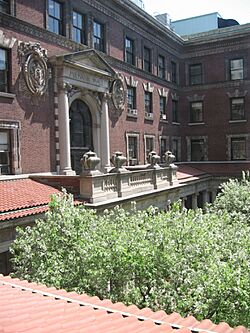
Barnard students can use the libraries at Columbia University. But Barnard also has its own library. The Barnard Library has special collections and archives. These documents show Barnard's history from when it started until today. One important collection is the papers of Ntozake Shange, a famous writer.
Zine Collection
The Barnard Zine Library is part of the Barnard Library. Zines are small, self-published magazines. This collection focuses on topics important to women, queer people, and people of color. In 2004, it became the first zine library in the U.S. to be fully cataloged. It opened for students to borrow zines in 2008. As of 2018, it had about 5,000 zines. The library also supports a student-run Barnard Zine Club.
Student Life
Student Groups
Every Barnard student is part of the Student Government Association (SGA). The SGA elects student leaders. Its goal is to help students share their ideas about things that affect the Barnard community.
Student groups at Barnard include theater and music groups, language clubs, and literary magazines. There is also a radio station called WBAR and a student newspaper called the Barnard Bulletin. Students can also join community service groups and many others.
Barnard students can join most clubs and activities at Columbia University. Columbia students can also join most Barnard organizations. Barnard's McIntosh Activities Council (McAC) plans fun events on campus. These include "Big Sub" and "Midnight Breakfast."
Sororities
Barnard students can join different sororities. A sorority is a social club for women in college. Barnard does not fully recognize all the national sororities at Columbia. However, it does help fund Barnard students who live in Columbia housing through these groups. The Alpha chapter of Alpha Omicron Pi, a national sorority, was founded at Barnard in 1897.
Traditions
Barnard Greek Games: This is one of Barnard's oldest traditions. The Greek Games first happened in 1903. They were held every year until 1968. Since then, they have been brought back sometimes. The games involve competitions between each graduating class. Events have included Greek poetry, dance, chariot racing, and a torch race.
Take Back the Night: Every April, Barnard and Columbia students take part in the Take Back the Night march. This event started from a conference in 1988. It is a protest against violence. The march grew from less than 200 people in 1988 to over 2,500 in 2007.
Midnight Breakfast: This event marks the start of finals week. It is a very popular and old tradition. The student-run activities council, McAC, hosts it. They serve breakfast foods, and the menu often matches a fun theme. College deans, trustees, and the president serve food to about a thousand students. It happens the night before finals begin each semester.
Big Sub: At the start of each fall semester, Barnard College provides a very long subway sandwich, over 700 feet long! Students can take as much as they want. The sub has different sections, including kosher, dairy-free, vegetarian, and vegan options. This event is also organized by McAC.
Academic Connections
Relationship with Columbia University
The relationship between Barnard College and Columbia University is unique and sometimes complex. Many people describe Barnard as part of Columbia. For example, The New York Times called Barnard "an undergraduate women's college of Columbia University." The front gates of Barnard also say "Barnard College of Columbia University."
Barnard describes itself as an independent college that is also an official college of Columbia University. It says it is "one of the University's four colleges, but we're largely autonomous, with our own leadership and purse strings." Students are advised to write "Barnard College, Columbia University" on their résumés.
Columbia considers Barnard one of its schools and an affiliated institution. Both Barnard and Columbia evaluate Barnard teachers for tenure (a permanent job). Barnard graduates receive Columbia diplomas signed by both the Barnard and Columbia presidents. A degree from Barnard College is considered to have the same value as a degree from Columbia College.
Barnard graduates are also part of the Columbia Alumni Association. They can receive honors like the annual Columbia Alumni Medal. Barnard students wear the same graduation gowns as other Columbia undergraduates. Their degrees are given during the main University Commencement ceremony.
Before Columbia Admitted Women
In the early 1900s, Barnard and Columbia worked together to open Columbia classes to Barnard students. By 1900, Barnard students could attend Columbia classes in subjects like philosophy and science. In 1900, Barnard officially connected with Columbia. This allowed Barnard students to use Columbia's teaching and facilities. Some teachers even thought Barnard students were better than the male Columbia students!
From 1955, students from both colleges could take classes at the other school with permission. By 1973, no permission was needed. By the 1940s, other parts of Columbia University (besides Columbia College) already admitted women.
In the 1970s, Columbia faced money problems. They wanted to merge with Barnard to end single-sex education. But Barnard resisted because Columbia had a lot of debt. Barnard's leaders emphasized their connection to Columbia in their marketing.
In 1980, a Columbia committee suggested that Columbia College start admitting women without Barnard's help. In 1981, another committee found that Columbia was not as competitive as other Ivy League universities without women. They also thought admitting women would not hurt Barnard's student applications.
After Columbia Admitted Women
In January 1982, the two schools announced that Columbia College would start admitting women in 1983. Barnard's control over its teachers' tenure also increased. Applications to Columbia went up by 56% that year. This made admission more selective. Nine Barnard students transferred to Columbia. Eight students accepted by both colleges chose Barnard, while 78 chose Columbia. However, within a few years, both schools became more selective as more women applied than expected.
The Columbia-Barnard connection continued. As of 2012, Barnard paid Columbia about $5 million a year for their shared relationship. This agreement is renegotiated every 15 years. Even with this connection, Barnard is legally and financially separate from Columbia. It has its own teachers and leaders. It is also responsible for its own admissions, health services, and student support.
Barnard students can take most Columbia classes, and Columbia students can take most Barnard classes. Barnard students and teachers are part of the University Senate. Student groups like the Columbia Daily Spectator are open to all students. Barnard students play on Columbia sports teams. Barnard also uses Columbia's email, phone, and network services.
Barnard athletes compete in the Ivy League (NCAA Division I) through the Columbia-Barnard Athletic Consortium. This started in 1983. Because of this, Barnard is the only women's college with Division I athletics. There are 15 college sports teams. Students also play in club and casual sports. Before 1983, Barnard students competed as the "Barnard Bears." Before 1975, they called themselves the "Barnard honeybears."
Notable People
Barnard College has many famous graduates. They have become leaders in science, politics, medicine, law, education, and business. They include acclaimed actors, artists, astronauts, and writers.
Some notable graduates are:
- Louise Holland (1914), an academic
- Zora Neale Hurston (1928), an author
- Grace Lee Boggs (1935), an author and activist
- Patricia Highsmith (1942), an author
- Ronnie Eldridge (1952), a television host
- Phyllis E. Grann, former CEO of Penguin Putnam
- Helen Gahagan (1924), a U.S. Representative
- Erica Jong (1963), an author
- Helene D. Gayle (1970), a physician and public health official
- Susan N. Herman (1968), former president of the American Civil Liberties Union
- Judith Kaye (1958), former Chief Judge of the New York Court of Appeals
- Wilma B. Liebman (1971), former chair of the National Labor Relations Board
- Laurie Anderson (1969), a musician and performance artist
- Cynthia Nixon (1988), an actress and activist
- Jhumpa Lahiri (1989), an author and Pulitzer Prize winner
- Ann Brashares (1989), author of The Sisterhood of the Traveling Pants
- Amy Hwang (2000), a The New Yorker cartoonist
- Kelly McCreary (2003), an actress from Grey's Anatomy
- Greta Gerwig (2004), a writer and director
- Christy Carlson Romano (2015), a Disney Channel actress
-
Martha Stewart 1963, businesswoman, author, television personality
-
Lauren Graham 1988, actress, author
-
Joan Rivers 1955, comedian, actress
-
Greta Gerwig 2006, filmmaker
-
Norma Merrick Sklarek 1950, architect
-
Grace Lee Boggs 1935, author, social activist, philosopher
-
Helene D. Gayle 1976, physician, public health official
-
Ntozake Shange 1970, playwright, poet, author
-
Laurie Anderson 1969, performance artist, NASA's first Artist-in-Residence
-
Margaret Mead 1923, anthropologist
-
Cynthia Nixon 1988, actor, political candidate
-
Twyla Tharp 1963, choreographer
-
Zora Neale Hurston 1928, author
See also
 In Spanish: Barnard College para niños
In Spanish: Barnard College para niños
- Athena Film Festival
- Barnard Center for Research on Women
- Hidden Ivies: Thirty Colleges of Excellence
- Women's colleges in the United States
- List of coordinate colleges


